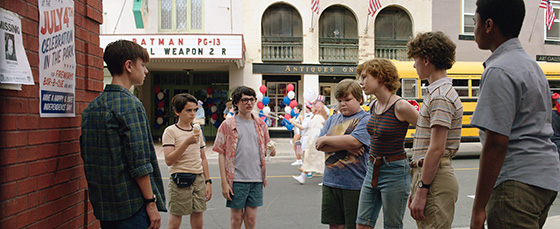IT

(L-R) JAEDEN LIEBERHER as Bill Denbrough, JACK DYLAN GRAZER as Eddie Kaspbrak, FINN WOLFHARD as Richie Tozier, JEREMY RAY TAYLOR as Ben Hanscom, SOPHIA LILLIS as Beverly Marsh, WYATT OLEFF as Stanley Uris and CHOSEN JACOBS as Mike Hanlon in New Line Cinema's IT, a Warner Bros. Pictures release.

According to the CDC, bullying and child abuse are the leading causes of childhood suicide resulting in roughly 4,400 deaths per year. While these themes have recurred in the periphery of many coming-of-age films, so rarely has cinema tried to deal with it head on without sensationalizing the matter.
Generally, the horror genre seems to have been a Christian apologetics ministry to warn against the evils of premarital sex—with rare exception. In Clive Barker’s HELLRAISER, a young girl’s father murders her occult-obsessed uncle but proves himself to be an incestuous lech. In M. Night Shyamalan’s film, THE SIXTH SENSE, a subplot involves Munchausen-by-Proxy. A young girl played by Mischa Barton is being poisoned by her mother. She tapes the incidents and, after her death, reveals the tape to Cole (Haley Joel Osment). The mother is caught just as she’s beginning to poison the girl’s younger sister.
The first cinematic adaptation of Stephen King’s IT (previously incarnated as a rather incomprehensible mini-series) personifies evil in the form of Pennywise the Dancing Clown (Bill Skarsgård). Reputedly a centuries-old eldritch demon, Pennywise (a.k.a. “It”) feeds on the fears of children in the mining town of Derry, Maine. He’s first encountered when Bill Denbrough’s (Jaeden Lieberher; MIDNIGHT SPECIAL) little brother, Georgie (Jackson Robert Scott), floats a paper boat along the neighborhood street curb. Georgie loses the boat down the sewer drain, where he discovers the peculiarly cherubic Pennywise who utters ominously, “We all float down here.”
A year later, still guilt-ridden (he let Georgie go out alone) and determined to find his missing brother, Bill and several other bullied/abused children discover the demon lives in an abandoned house—some kind of nexus of evil incidents that have left hundreds of children dead or missing over the past two hundred years. Each of the children has encountered It in one form or another: Overcompensating for his insecurities with mom jokes, the bespectacled, diminutive Ritchie Tozier (Finn Wolfhard) fears being abducted and forgotten about. Never without his inhaler, Eddie Kaspbarak (Jack Dylan Grazer) fears asphyxiation. Stanley Uris (Wyatt Oleff) fears being picked on for his Judaism, though he is also deeply skeptical of religion. Mike Hanlon, the only minority among the group, fears ostracism from the all-white community but also lives with the memory of watching his family burn to death.
While many of the others have run ins with the school bully, Henry Bowers (Nicholas Hamilton), it is the overweight eccentric bibliophile (and secret NKOTB aficionado) Ben (Jeremy Ray Taylor), for whom Nicholas is a personal, external tormentor. Likewise, Bev’s (Sophia Lillis) father (Stephen Bogaert) abuses her. To me, it is inevitable that Bev and Ben would be the most hardened of survivors among this so-called Losers Club.
Directed by Andy Muschietti and written by Chase Palmer, Cary Fukunaga, and Gary Dauberman, IT is replete with “jump scares” and visual/body horror. However, the film shines when focused on the children’s relationships with one another, their mutual distrust of authority (adults act oblivious, almost purposely, to the disappearances; one draws parallels to child abuse scandals within the Church), and their pact to fight back. Still, the director and editor don’t allow these scenes to breathe for a beat or two, cutting right back into the headlong violence.
The children’s resolve to defeat Pennywise also bears elements of Campbell’s Hero’s Journey, as do many of King’s stories which revolve around childhood traumas, survival through shared struggle and conquering personal demons—figurative and literal. But like another monomyth, Tolkien’s Lord of the Rings, the protagonist does not emerge unscathed.
Many critics and viewers took to calling out M. Night Shyamalan’s use of the Final Girl trope in his thriller, SPLIT. In Shyamalan’s film, the Beast tells her would-be hero that he preys only on the unbroken because they are weak. This drew serious criticism from psychiatric circles that fear such dramatic mischaracterizations underplay the severity of prolonged damage done by abuse.
The difference in both King’s novel, the miniseries, and presumably the planned sequel to this film, is that twenty-seven years later when the demon returns, the children are each deeply, psychologically scarred in their own ways. For them, as well as for Bilbo Baggins, the “hero” in Tolkien’s mythology, the battle scars are too many. Those of us who have endured years of bullying and/or abuse are not “heroes” in any sense. Our memories are often vacated as the only means by which we cope day to day. Like the evacuees of Dunkirk, all we did was survive… and that was enough.